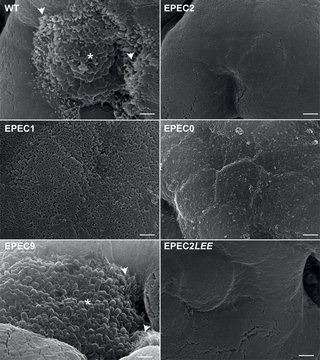PLoS Pathogens ( IF 5.5 ) Pub Date : 2017-10-30 , DOI: 10.1371/journal.ppat.1006706 Massiel Cepeda-Molero 1 , Cedric N Berger 2 , Alistair D S Walsham 3, 4 , Samuel J Ellis 3, 4 , Simon Wemyss-Holden 5 , Stephanie Schüller 3, 4 , Gad Frankel 2 , Luis Ángel Fernández 1

|
Enteropathogenic E. coli (EPEC) is a human pathogen that causes acute and chronic pediatric diarrhea. The hallmark of EPEC infection is the formation of attaching and effacing (A/E) lesions in the intestinal epithelium. Formation of A/E lesions is mediated by genes located on the pathogenicity island locus of enterocyte effacement (LEE), which encode the adhesin intimin, a type III secretion system (T3SS) and six effectors, including the essential translocated intimin receptor (Tir). Seventeen additional effectors are encoded by genes located outside the LEE, in insertion elements and prophages. Here, using a stepwise approach, we generated an EPEC mutant lacking the entire effector genes (EPEC0) and intermediate mutants. We show that EPEC0 contains a functional T3SS. An EPEC mutant expressing intimin but lacking all the LEE effectors but Tir (EPEC1) was able to trigger robust actin polymerization in HeLa cells and mucin-producing intestinal LS174T cells. However, EPEC1 was unable to form A/E lesions on human intestinal in vitro organ cultures (IVOC). Screening the intermediate mutants for genes involved in A/E lesion formation on IVOC revealed that strains lacking non-LEE effector/s have a marginal ability to form A/E lesions. Furthermore, we found that Efa1/LifA proteins are important for A/E lesion formation efficiency in EPEC strains lacking multiple effectors. Taken together, these results demonstrate the intricate relationships between T3SS effectors and the essential role non-LEE effectors play in A/E lesion formation on mucosal surfaces.
中文翻译:

肠道致病性大肠杆菌对人体肠黏膜的附着和消除 (A/E) 损伤取决于非 LEE 效应器
肠致病性E . 大肠杆菌(EPEC) 是一种导致急性和慢性小儿腹泻的人类病原体。EPEC 感染的标志是在肠上皮中形成附着和消失 (A/E) 病变。A/E 病变的形成是由位于肠上皮清除 (LEE) 致病岛基因座上的基因介导的,该基因编码粘附素 intimin、III 型分泌系统 (T3SS) 和六个效应子,包括必需的易位 intimin 受体 (Tir) . 十七个额外的效应子由位于 LEE 之外的插入元件和前噬菌体中的基因编码。在这里,使用逐步方法,我们生成了一个缺少整个效应基因 (EPEC0) 和中间突变体的 EPEC 突变体。我们证明 EPEC0 包含一个功能性 T3SS。表达 intimin 但缺乏所有 LEE 效应器但 Tir (EPEC1) 的 EPEC 突变体能够在 HeLa 细胞和产生粘蛋白的肠道 LS174T 细胞中引发强烈的肌动蛋白聚合。然而,EPEC1 无法在人体肠道上形成 A/E 病变。体外器官培养(IVOC)。在 IVOC 上筛选与 A/E 病变形成有关的基因的中间突变体表明,缺乏非 LEE 效应子的菌株具有形成 A/E 病变的边缘能力。此外,我们发现 Efa1/LifA 蛋白对于缺乏多种效应器的 EPEC 菌株的 A/E 损伤形成效率很重要。总之,这些结果证明了 T3SS 效应器与非 LEE 效应器在粘膜表面 A/E 病变形成中所起的重要作用之间的复杂关系。











































 京公网安备 11010802027423号
京公网安备 11010802027423号